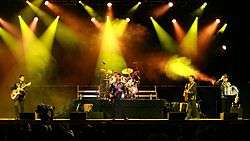Los Tigres del Norte
| Los Tigres del Norte | |
|---|---|
 Los Tigres del Norte at the Chumash Casino Resort in Santa Ynez, California. | |
| Background information | |
| Origin | Sinaloa, Mexico |
| Genres | Norteño |
| Years active | 1968–present |
| Labels | Fonovisa, Fama World Circles (1968-1984) |
| Associated acts | Zack de la Rocha |
| Website | lostigresdelnorte.com |
| Members |
Jorge Hernández Hernán Hernández Eduardo Hernández Luis Hernández Óscar Lara |
| Past members | Freddy Hernández |
Los Tigres del Norte (English: The Tigers of the North) is a norteño-band ensemble based out of San Jose, California with origins in Rosa Morada, a sindicatura in Mocorito, Sinaloa, Mexico.
History

The group was started by Jorge Hernandez, his brothers, and his cousins. They then began recording after moving to San Jose, California in the late 1960s, when all the members were still in their teens.[1] They were sponsored by a local record company, Discos Fama, owned by an Englishman named Art Walker, who took them under his wing and helped them find jobs and material, as well as recording all of their early albums.[1]
The Tigres were at first only locally popular, but took off after Jorge and Art Walker heard a Los Angeles mariachi singer perform a song in the early 1971 about a couple of drug runners, Emilio Varela and Camelia la Texana. There had been occasional ballads (corridos, in Mexican terminology) about the cross-border drug trade ever since Prohibition in the 1920s, but never a song as cinematic as this, featuring a woman smuggler who shoots the man and takes off with the money. After getting permission to record this song, Los Tigres del Norte released "Contrabando y traición" ("Contraband and Betrayal") in 1974.[2] The song quickly hit on both sides of the border, inspired a series of movies, and kicked off one of the most remarkable careers in Spanish-language music.
In norteño/conjunto form (a style featuring accordion that originated along the Texas border region), Los Tigres del Norte have been able to portray "real life" in a manner that strikes a chord with people across the Americas. Many of their most popular songs consist of tales or corridos about life, love, and the struggle to survive in an imperfect world. They regularly touch on the subject of narcotics and illegal immigration, but they have also shared stories of love and betrayal between a man and a woman. Together, the band and its public has turned norteño music into an international genre. The band has modernized the music, infusing it with bolero, cumbia, rock rhythms, waltzes, as well as effects of machine guns and sirens integrated with the music.
On January 9, 2007, Los Tigres del Norte was honored as a BMI Icon at the 14th annual BMI Latin Awards. Los Tigres, who were saluted that evening with an all-star musical tribute, were being honored as BMI Icons for their "unique and indelible influence on generations of music makers." They joined an elite list that includes such Latin music giants as Juan Luis Guerra and Carlos Santana.[3]
On October 16, 2009, Los Tigres del Norte held a Concert in Guadalupe, Nuevo Leon (outside of Monterrey) at the Annual Expo Guadalupe that lasted 12 hours, breaking their own record of 9 hours from previous year. It began on Saturday night and ended on Sunday at 9 a.m., not uncommon for Los Tigres del Norte. They are known for having encores at their concerts that can last more than an hour after the scheduled ending of the concert.
They have performed before the United States Armed Forces in Japan and South Korea.[4]
In 2010, the band made headlines by joining in a massive international boycott of the U.S. state of Arizona, in response to the Support Our Law Enforcement and Safe Neighborhoods Act.[5]
On October 8, 2013, Los Tigres del Norte played at an immigration reform rally on the National Mall in Washington, D.C. Their setlist included songs that underscored the themes the rally would address including “La Puerta Negra,” “De Paisano a Paisano,” and “Mis Dos Patrias.” The band was introduced by then Minority Leader Nancy Pelosi (D-Calif.) Mexican-American singer-songwriter and actress, Lila Downs, also accompanied the group in a series of duets.[6]
In 2014 Los Tigres del Norte released the album Realidades, which contains the song “Era Diferente” (meaning “She Was Different”) about a lesbian teenager who falls in love with her best friend; according to lead singer and songwriter Jorge Hernandez, this is the first time a norteño group has ever written a gay love song.[7][8]
The band has sold 32 million records as of 2007.[9] As of 2015 they have six Grammys and six Latin Grammys and a star on the Hollywood Walk of Fame.[8] They received the Special Recognition (Spanish language) Award at the 26th annual GLAAD Media Awards in 2015, for their song "Era Diferente" ("She Was Different").[10] The band ranked at number 15 in the list for "The 30 Most Influential Latin Artists of All Time" by Billboard magazine.[11]
All group members became American Citizens.[12]
Philanthropy
In May 2000, Los Tigres del Norte founded the Los Tigres del Norte Foundation which is committed to fostering appreciation and preservation of Mexican and Mexican-American folklore. The Los Tigres del Norte Foundation donated $500,000 to the UCLA Chicano Studies Research Center, which was used to digitize over 32,000 Spanish language recordings contained in the Strachwitz Frontera Collection.[13]
Members
- Jorge Hernández – director, lead vocals, accordion
- Hernán Hernández – bass, vocals
- Eduardo Hernández – accordion, saxophone, bajo sexto, vocals
- Luis Hernández – bajo sexto, vocals
- Óscar Lara – drums
Former members
- Raúl Hernández – bajo sexto, vocals (left the group in 1996 to become a soloist)
- Guadalupe Olivo – saxophone, accordion (left the group in 1988 for health reasons, returned in 1997, then left again in 2001 for the same reasons, and has since performed in Raul Hernández' band)
- Freddy Hernández – percussion (deceased)
Discography
This list excludes the many "Greatest Hits" compilations.
- Juana La Traicionera/Por El Amor A Mis Hijos (1968)
- Sufro Porque te Quiero/La Cochicuina (1969)
- Cuquita (1971) (Official First Album)
- El cheque (1972) Mexican Release Album Compilation Of Por Amor A Mis Hijos / Sufro Porque Te Quiero
- "Mi Caballo Ensilado" (Single) (1973)
- Si,Si,Si/Chayo Chaires (1973)
- "No Llorare" (Single) (1974)
- Contrabando Y Traición* (1974)
- La Banda Del Carro Rojo* (1975)
- Pueblo Querido* (1976)
- Grandes Exitos De... (3-LP Compilation)(1976)
- Vivan Los Mojados* (1977)
- Numero Ocho (1978)
- El Que Tanto Te Amo (Single)(1978)
- Rio Magdalena (Single) (1978)
- Hermosa Luna (Single) (1979)
- El Tahúr* (1979)
- Plaza Garibaldi (1980)
- ...Un Día A La Vez!* (1981)
- Éxitos Para Siempre...* (1982)
- Carrera Contra La Muerte* (1983) (last Discos Fama album)
- Jaula De Oro (1984) (first Profono album)
- "Adolfo Mi Compadre" (Single) (1984)
- Disco Poster (4-track compilation released by Mexican magazine Disco Poster) (1984)
- La Tumba Del Mojado-Internacionalmente Norteños (1984) (Some sources mistakenly claim that this album was released in 1976)
- A Ti Madrecita (1985) (reissued in 2015 with 4 new songs)
- El Otro México (1986)
- Gracias!... América... Sin Fronteras (1987) (first Fonovisa album, winner of the 1988 Grammy award for Best Mexican-American Performance)
- Ídolos Del Pueblo (1988) (last album with Lupe Olivo)
- Corridos Prohibidos (1989) (first album with Eduardo Hernández)
- Triunfo Sólido – Mi Buena Suerte (1989)
- Para Adoloridos (1990)
- Incansables! (1991)
- Con Sentimiento Y Sabor – Tan Bonita (1992)
- Una Noche Con Los Tigres Del Norte (1992)
- La Garra De... (1993)
- Los Dos Plebes (1994)
- El Ejemplo (1995) (last album with Raul Hernández before becoming soloist)
- Unidos Para Siempre (1996) (first album with Luis Hernández & Guadalupe Olivo returning to the group)
- Jefe de Jefes (1997)
- Así Como Tú (1997)
- Herencia de Familia (1999)
- De Paisano a Paisano (2000) (last album with Lupe Olivo)
- Uniendo Fronteras (2001)
- La Reina del Sur (2002)
- Pacto de Sangre (2004)
- Directo al Corazón (2005)
- Historias Que Contar (2006)
- Detalles y Emociones (2007)
- Raíces (2008)
- Tu Noche Con... Los Tigres del Norte (2008)
- La Granja (2009)
- La Granja: Secreta (2010)
- MTV Unplugged: Los Tigres del Norte and Friends (2011)
- Realidades (2014)
- Desde el Azteca (2015)
- Ataud (2016)
The asterisk* indicates albums rerecorded by the group for Profono between 1984 and 1986 following a legal battle over the rights to their recordings for Fama.
Singles
- Las Tres Mujeres
- Los Sufrimientos
- Polka Texas
- Ya Cambiara Mi Destino
- Juana
- Morena De San Francisco
- Mi Caballo Ensillado
- No Llorare
- Rio Magadalena
- El Que Tanto Te Amo
- Hermosa Luna
- Los Vigilantes§
- Adolfo Mi Compadre
- Sufro Porque Te Quiero
- Un Cuento De Navidad
- La Navidad De Los Pobres
- Mujeriego (feat. Don Francisco)
- Por Amor
- Aguas Revueltas
- El Enfermito
- La Bala
- Tu Carcel (feat. Marco Antonio Solis)
- Ataud
Films
Through their career, Los Tigres Del Norte have appeared in numerous Mexican films, many of which are based on some of their hit songs. In terms of genre, they range from action to drama. Many of the actors in these films include Mario and Fernando Almada, Eric Del Castillo, Pedro Infante, Jr., Jorge Reynoso, Lucha Villa, Cecilia Camacho, and Bernabe Melendez "El Gatillero".
- La Banda Del Carro Rojo (1976)
- La Muerte Del Soplon (1978)
- La Jaula De Oro (1986)
- La Puerta Negra (1988)
- Tres Veces Mojado (1988)
- Ni Parientes Somos (1989)
- La Camioneta Gris (1989)
- Los Tres Gallos (1990)
- Amor A La Medida (1992)
- La Misma Luna (2008)
References
- 1 2 Wilkinson, Alec. "Alec Wilkinson, "Immigration Blues," The New Yorker magazine, May 24, 2010". Newyorker.com. Retrieved May 14, 2012.
- ↑ Biography at Univision.com
- ↑ "Los Tigres del Norte To Be Honored as BMI Icons at 14th Annual Latin Awards". bmi.com. Retrieved October 11, 2010.
- ↑ "Visión Hispana". Visionhispanausa.com. April 15, 2010. Retrieved May 14, 2012.
- ↑ El Correo de Guanajuato: "Tigres del Norte, participan en boicot contra Arizona" (in Spanish)
- ↑ Montgomery, David (2013). "Los Tigres provide soundtrack for immigrants' lives."The Washington Post. Retrieved on April 27, 2014.
- ↑ "Realidades - Los Tigres del Norte | Releases". AllMusic. 2014-10-07. Retrieved 2015-03-25.
- 1 2 Yezmin Villarreal (2015-03-21). "Los Tigres del Norte Are Making Gay Norteño History". Advocate.com. Retrieved 2015-03-25.
- ↑ article in Washington Post, February 18, 2007
- ↑ "Norteño Kings Los Tigres del Norte on Being Honored for Gay Love Song 'Era Diferente': 'This Brings Us Great Pride'". Billboard. 2015-03-21. Retrieved 2015-03-25.
- ↑ "The 30 Most Influential Latin Artists of All Time". Billboard. 2015-04-28. Retrieved 2015-07-10.
- ↑ http://www.nytimes.com/2014/06/29/arts/music/los-tigres-del-norte-breaks-boundaries.html?_r=0
- ↑ Los Tigres del Norte Foundation. Retrieved on April 27, 2014.
External links
- Official website (in Spanish & English)
- Universal Music Latin Entertainment | Los Tigres del Norte
- Los Tigres del Norte at MySpace.com
- Los Tigres del Norte on YouTube.com
- Interview with Acceso Total, video (in Spanish)
